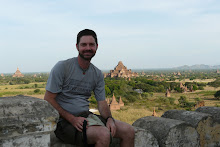Today was our last day but it was still a full safari day. We got up at 6.30am to pack up everything. We ate breakfast and left at 8. It was only a short drive to the descent road. There is only one road to descend into the crater and only one road out of the crater. Ngorongoro is one of the world's largest unbroken calderas. It measures 20km across its widest point and was lush and green on the floor. Due to abundant grass and a steady supply of water, many animals live permanently in the crater. There can be up to a million hoofed animals and these in turn feed a healthy predator population. There are many buffaloes and zebras as we first start driving in the crater. The crater is mostly flat and treeless with a large salt lake in its center but with other smaller freshwater lakes feed by underground springs. We come across a family of foxes close to the road. There are really small and cute and new for me. We see many other animals but nothing unusual until Isaac stops the Landcruiser a few hours later. He checks a large grey spot in the distance and confirms his suspicions. It is a black rhino. Actually it is 2 black rhinos and one young. They are lying down but later get up and walk around. Though they are far I can clearly see them. There is another big animal crossed off my 'wishlist'. There are about only 23 black rhinos living in the crater. Africa has the black rhino and the white rhino, both have been poached to near extinction for their horns. The white rhino was reduced to a single population in Umfolozi national park in South Africa. This population has been used to relocate animals to areas where they used to graze, including Lake Nakuru national park in Kenya where I saw them on the beginning of my trip. I saw many white rhinos in Kruger national park in South Africa but black rhinos are very rare there. I have been wanting to see one since my first safari. There are many differences between black and white rhinos but most of these are small. Some of the major differences are the type of eating they do. The black rhinos are grazers, eating leaves of small shrubs and grass. White rhinos are browsers with a low hung head for eating grass and will congregate in groups more than the mainly solitary black rhinos. Black rhinos are also known to be more aggressive and will readily charge just about anything. So, in a way it was good that this rare family of black rhinos was in the distance.
We drove around many corners of the crater before going for lunch at noon. We had lunch among a collection of skulls and bones of mostly buffalo. There were many birds around and Isaac told us to watch our food. I threw one piece of rice for a single bird and in a second I had 20 birds right beside. I could reach out and touch them. They flew off suddenly and I got a birdwing in the face by a large, predatory black Kite that was after my food and the birds. It was the first time I've actually been hit by a bird, I couldn't believe it! We finished lunch and would have a short game drive before leaving the crater.
Only minutes from leaving the lunch spot we stopped. There were 2 cheetahs here, walking and lying around. I was blown away, more cheetahs! I was so happy. There were also a few huge bull elephants in the distance. Only solitary old males descend into the crater, family herd of elephants aren't found here. The area around the ascent road is concentrate densely with zebras and wildebeests. They were everywhere, walking all over the road. We had to constantly slow down to allow them to move off or drive around them. A very dark rainfilled sky loomed ahead of us. We drove into torrential rain. The windows fogged up but Isaac still had to be careful as there were still many zebra on the road. We climbed out of the crater and it stopped raining. We had a long, uneventful drive back to Arusha. Even though it rained a lot on our safari, the area close to Arusha was still dry and dusty.
I really enjoyed the crater and it was a highlight of my trip, as was the Serengeti. This northern park safari circuit was my last activity before heading home in a few days.
Subscribe to:
Post Comments (Atom)

No comments:
Post a Comment
Note: Only a member of this blog may post a comment.